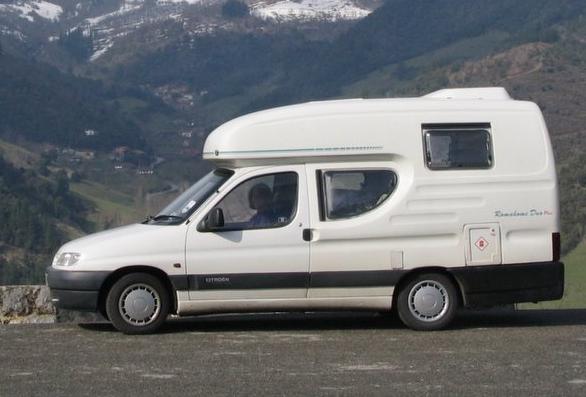Wednesday 8th March 2006, Verneuil-sur-IndreToday has been spent travelling north through a wet and bedraggled countryside. The area of Brenne is one of lakes anyway and most of these have flooded. Frequently we found ourselves driving along minor roads that were no more than raised causeways between huge sheets of water with only ducks and swans for company. The whole of Europe seems to have been nothing but rain and water for the last six months, interspersed with moments of bright sunshine. As we passed into the department of Indre the river had burst its banks with trees that should have been at the edge, now standing way out in the middle. It was the same as we crossed the Cher and the Loire. Normally we have found the Loire to have huge sandbanks along its edge and to have a series of green islands standing in a wide shallow river. Now all the rivers seemed to have converged to form an endless grey sheet of water that matched the sky while the rain and hail continued to fall.
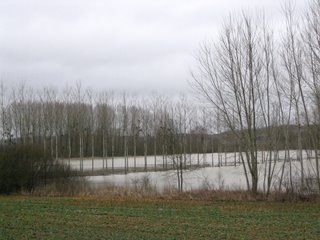 The river Indre in flood
The river Indre in flood
We stopped at Loches – or as Ian calls it, Sploches – parking Modestine, with some reservation, in the only car park, near the river which was almost touching the arch of the bridge as it swirled beneath. As we parked a vehicle drew up behind us hooting furiously and two people got out. Wondering what we had done wrong, we went to meet them. “It
is you! We recognised Modestine!” they cried. It turned out to be friends of Christine and Mostyn who had made us so welcome when we were staying at Ambre-les-Espagnolettes! We had met Susan and Ray, who come from Exeter, a couple of times and, during the period that we were travelling around Spain, they had moved up to live in the Loire Valley near Tours. However, their house was not yet ready for occupation and they had settled at Loches for a couple of months renting a Gite. They formerly owned a Romahome so were instantly attracted when they saw Modestine on the wet streets of the town.
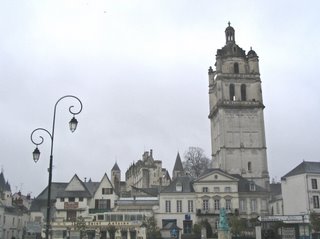 Loches and the tower of the Collegiale
Loches and the tower of the Collegiale
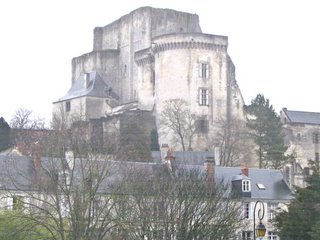 The 11th century donjon at Loches
The 11th century donjon at Loches
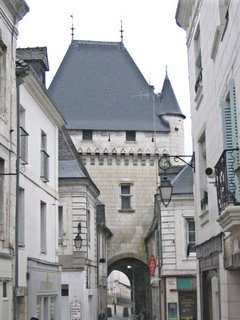 Porte des Cordeliers, Loches
Porte des Cordeliers, Loches
 Gateway through the ramparts, Loches
Gateway through the ramparts, Loches
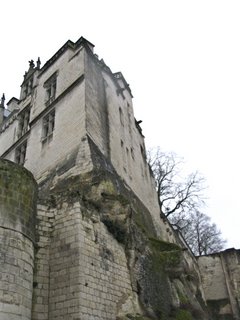 Logis Royal, Loches
Logis Royal, Loches
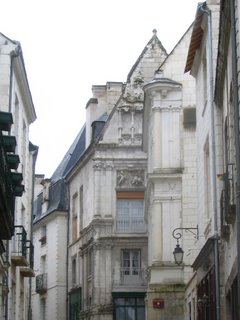 Chancellerie, Loches
Chancellerie, Loches
Declaring this was no weather for camping in a waterlogged field – a sentiment with which we totally agreed – they told us to turn up at their gîte when we had finished Sploching. So we spent a couple of hours exploring the steep streets of this picturesque town with its 11th century Donjon on the hilltop above the town, from where we had a vista over the grey floodwaters covering the surrounding countryside.
Arriving at Susan and Ray’s country gîte, we left Modestine on the only patch of road not ankle deep in mud and were welcomed into the warmth of the old converted water mill with its stone fireplace and roof of huge timbered beams. Here we were "hosed down" in hot water, dried out, plied with the local Touraine wine and given a hot supper, convivial conversation and a warm comfortable bed. (Now do you all believe Modestine is a very special vehicle?)
Friday 10th March 2006, Caen, Calvados We are now back in Caen staying with our good friend Geneviève for a few days before taking the ferry to Portsmouth for a brief return to Exeter and to visit our family. This for us is the real France, surrounded by French friends, in a city crowded with history – from William the Conqueror to the D-Day Landings. The surrounding Normandy countryside is varied with the pretty orchards and the speckled cows of the Pays d’Auge, the crags, valleys and woodland of the Swiss Normande, the endless flat fields of arable crops out on the Plaine de Caen, and the smaller fields surrounded by hedgerows that form the Bocage, lying between Cherbourg and Bayeux. There are the endless sandy beaches which witnessed the débarquement of the Allied forces along their entire length on 6th June 1944. Here there are still the concrete remains of stone bunkers, cratered cliff tops, and even the rusting platforms of the Mulberry harbour, towed across the Channel from Britain, at Arromanches that provided the landing facilities for the tanks, fuel and soldiers on that day. All around the countryside can be found peaceful, beautifully tended War Graves cemeteries where American, British and Canadian soldiers killed in the fighting now lie.
We arrived back in Caen last night but were too tired to think about blogging, so this is two days in one.
We left Loches on Thursday and headed towards Amboise, stopping at the delightfully pretty little village of Chedigny to look at the home Susan and Ray will shortly be occupying. We continued through the beautiful but wet wooded countryside with its many turreted chateaux, past Amboise to Pocé. Here we stopped to explore. Geneviève’s mother Germaine owns a small house here and for years the family have used it for their holidays. We had been offered the opportunity to rent it over the winter if we tired of travelling but we had never actually seen the village. We rang Germaine in Caen to ask for the address of her property and to warn the family we would be returning later in the day. Pocé turned out to be a typical little French village of stone buildings with a huge church and a small brick built château with pointed black slate roofs set in parkland open to the public. Its greatest asset is its proximity to so many of the delightful towns, villages and country châteaux of the Loire Valley.
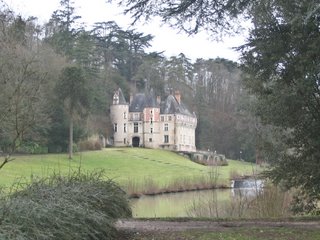 Le Château de Pocé
Le Château de Pocé
From here we headed across country, taking the most direct route back to Caen. The delight of travelling in France is that it is perfectly possible to travel almost anywhere in the country without touching on motorways or even les routes nationales. Our journey was along deserted departmental routes passing through countless stone villages and allowing us to fully appreciate the wet face of rural France. We stopped for a break at Lavardin, listed as yet another of France’s most beautiful villages, and we soon realised why. Apart from it picturesque main street and the romantic ruins of the castle on the hill behind, it has a wonderful Romanesque church where the interior is bright with colourful 12th century frescoes in an excellent state of preservation. We understand that there are similar churches in the Vendôme area with mediaeval wall paintings. The area merits further investigation one day.
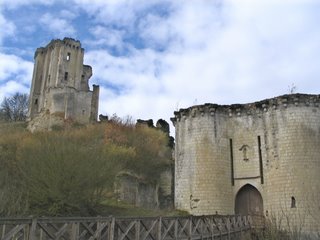 Ruines of the château at Lavardine
Ruines of the château at Lavardine
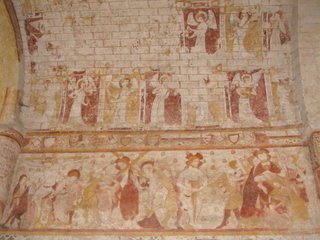 12th century fresco depicting the Passion, St. Genest, Lavardine
12th century fresco depicting the Passion, St. Genest, Lavardine
 Last judgment - condemned souls pushed towards the devil, 12th century, St. Genest, Lavardine
Last judgment - condemned souls pushed towards the devil, 12th century, St. Genest, Lavardine
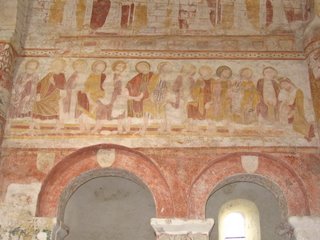 Washing of the disciples' feet,12th century, St. Genest, Lavardine
Washing of the disciples' feet,12th century, St. Genest, Lavardine
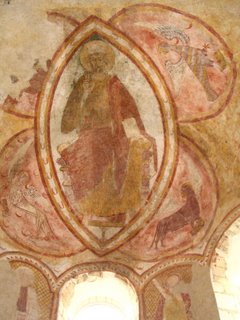 Christ in majesty in a mandorla surrounded by symbols of the evangelists, 12th century, St. Genest, Lavardine
Christ in majesty in a mandorla surrounded by symbols of the evangelists, 12th century, St. Genest, Lavardine
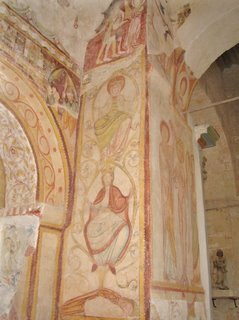 Tree of Jesse, Mary and King David enthroned, 12th century, St. Genest, Lavardine
Tree of Jesse, Mary and King David enthroned, 12th century, St. Genest, Lavardine
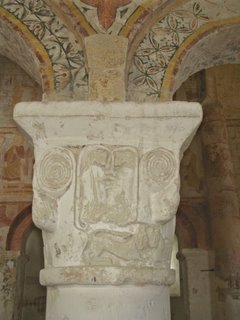 Capital, late 11th century, St. Genest, Lavardine
Capital, late 11th century, St. Genest, Lavardine
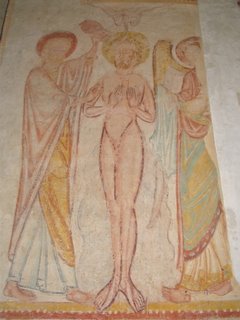 Baptism of Christ, late 12th century, St. Genest, Lavardine
Baptism of Christ, late 12th century, St. Genest, Lavardine
 St Thibault and St Maur, 15th century, St. Genest, Lavardine
St Thibault and St Maur, 15th century, St. Genest, Lavardine
As we continued to Caen we were continuously passing from black leaden skies hurling down hailstones to bright blue skies and sunshine. Gradually the landscape became familiar and we found ourselves driving past Camembert, Vimoutiers and Livarot, all famed for their Normandy cheese and dairy produce. Around 7pm we arrived in Caen to find the same warm welcome we always receive from Geneviève and the smell of a delicious supper wafting from the kitchen. Somehow time seemed to collapse and it seemed hours rather than months since we last sat together with glasses of wine, catching up on news together. It has been a fantastic seven months of travel and in many ways it seems almost unreal. However, we have the blog, over 4,000 photos and 12,500 miles added to Modestine’s milometer to prove we did it!
This morning, Friday 10th March, has been spent cleaning Modestine inside and out. She was pretty filthy after the last two months around Spain and Portugal and the storms and rains of France. The washing machine has been chugging away all day and we are now fit to be seen in public. We’d reached the stage where we were afraid of being directed to one of the many nomad sites we passed across France, called “terrain de gens de voyage.” Now though, we could turn up at a mayoral reception anywhere without the risk of being turned away as vagabonds!
Saturday 11th March 2006, Caen, CalvadosThis morning the French news was of floods across the country particularly in Gascony and the Jura. At Salies de Bearn the river had burst its banks. As Ralph and Ruth live only a few metres away we rang Ralph, concerned not only that they may be flooded, but that medical care may not have been able to reach Ruth. Fortunately they have so far avoided being flooded and the waters are now subsiding though many of the surrounding properties have flooded cellars and everywhere is being pumped out.
A phone call to Susanne in Champagne-sur-Loue confirmed that the Loue has also burst its banks and the camping terrain there has been completely flooded. In addition it has been snowing heavily during the night and the Clos and vineyards are under a white blanket. The pansies we left as a remembrance have been flowering but since last night they are hidden deep beneath the snow.
Here in Normandy the rest of the day has been delightful for us although we have done very little of note, simply enjoying being in a big warm house with friends and a convivial lunch with members of the family and a winter walk around the local district during the afternoon. Modestine stands on the driveway glad not to have been called into active service for a couple of days!
Sunday 12th March 2006, Caen, CalvadosThis morning we enjoyed our regular Sunday morning treat in Caen. We walked down to the Port on the river Orne in the town centre and joined a large proportion of the city's community wandering around the huge weekly market. Here you can buy anything from a Tunisian couscous to a live chicken, a conger eel to a double bed, or goat's cheese wrapped in straw to a sink plug! It was bitterly cold and we soon sidled off to the crowded PMU café for cups of sweet hot chocolate and to watch the marketers filling in their betting slips as they crowded around the television in the corner. On our way home we bought a couple of 5 litre containers of Bordeaux red wine to take back to England for our kids. The lady in the shop was feeling generous and gave us a very nice bottle of Graves as a present.
During the afternoon we drove down to the Ouistreham cross-channel ferry port and bought our ticket for Wednesday morning. It seemed slightly less cold here than in Caen and we were stunned by the clarity of the light over the sea. No wonder this area has been so loved by artists. The sea and the sky merged together in a wide grey, green, white and blue horizon that seemed to stretch to infinity. Families were out walking along the sea front, watching the ferry leave for Portsmouth, rollerblading, cycling or skateboarding, pushing babies in prams, horse riding or sand yachting along the firm sand of the endless beach.
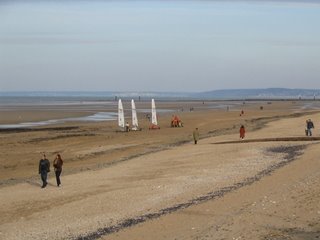 Sand yachts on the beach at Ouistreham, Normandie
Sand yachts on the beach at Ouistreham, Normandie
 Brittany Ferries ship leaving Ouistreham for Portsmouth
Brittany Ferries ship leaving Ouistreham for Portsmouth
 Seafront houses at Ouistreham, Normandy
Seafront houses at Ouistreham, Normandy
We returned home in time to discover France has totally beaten England at rugby, and to take Genevieve's son Etienne to the station for the evening train back to Paris where he is studying chemistry at the Ecole Normale.
During the evening we were joined for supper by several friends from Caen library service whom we have known for many years, and by our friend Claire and her daughter Katie whom we have known since she was 10 years old and who is expecting her second baby in a few weeks time. Everyone here it seems has been following our travels on their workplace desktops and came to welcome us back from the first part of our travels. Ian turned out to be the only male amongst seven women!
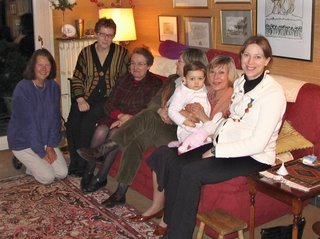 All the ladies at the supper party
All the ladies at the supper party
Monday 13th March 2006, Caen, CalvadosThis morning Genevieve had left for work by the time we were up and the morning was spent phoning or emailing friends, and loading on the latest addition to our blogsite. Just after lunch we walked down into the town centre to see Odile, another friend still working actively for Caen Municipal Library and heavily involved in liaising between local schools and the municipal library in Caen and inviting many well known writers for young people to give talks in the library as well as working with libraries in Romania. We walked home in the bright winter sunshine, each carrying another heavy container of wine to take back to England.
In the evening Geneviève's mother Germaine rang to invite us round for an evening aperitif. It has generally been a very enjoyable and relaxing day, transferring our bikes Hinge and Bracket to Geneviève's basement until we return and packing everything we won't need again during our travels into Modestine - such as a library of books, maps and dictionaries covering Spain and Portugal, a tent, an enormous awning, assorting cooking pots and a printer/scanner/photocopier! Hopefully we will also be able to leave in England our woolly hats and gloves, spare duvets and electric fire. How could we ever have thought it possible to fit everything into Modestine and still live in her?
Tuesday 14th March 2006, Caen, CalvadosOur last day and already we are looking forward to our travels when we return.
We drove across Caen this morning to see Claire and her daughter Katie for coffee, stopping to top-up Modestine's tank at Super U, the cheapest place to buy diesel fuel in Caen and considerably cheaper than England. Katie normally lives in Paris and is expecting her second baby soon. As we intend visiting Paris once we return, we may even be there to meet the new arrival! We have known both Katie and her brother Marc since they were young school friends of our own children. Marc even managed to join us all in Sri Lanka for Neil and Jeev's wedding a couple of years back. It has been delightful over the years watching them grow up, become fluent in English, and become personable young adults and parents.
Until now the weather has been glacial. Today however we were able to sit out in Geneviève's sheltered garden after lunch to drink our coffee in bright, warm sunshine. Geneviève of course was off at work all day so we have tried to earn our keep by tidying up the garden, emptying the plant tubs, sweeping down and generally reminding the garden that spring is on its way and it had better get on producing a few daffodils and primroses.
Later we made our way into town, visiting familiar haunts, stopping for a beer on a sunny terrace, pinching ourselves all over again – were we really retired and able to do this whenever the fancy took us? Caen is a very pleasant, lively university city with attractive parks and gardens, an imposing château, a range of museums, theatres and galleries. It is set in beautiful countryside sprinkled with pretty stone walled villages and within easy reach of the sea. It is only six hours on the ferry from Portsmouth. We know the area thoroughly and have many friends here. We browsed estate agents windows and tried to imagine living here forever, then thought of family, friends and our home in England. Dreams are wonderful but everything needs to be carefully balanced before making such a major decision.
We visited the hothouses in the lovely Jardin des Plantes. This has always been a delight and a good place to visit on a chilly day with temperatures in the tropical house averaging 35 degrees with a high moisture content. It was almost like being back in the jungle of Sri Lanka – without the risk of encountering any wild animals, though we did see a stuffed monkey or two, just to add atmosphere! There are also aquariums of tropical fish and a covered pool where spoilt terrapins bask in the abnormal heat. This really is an attractive place, attached to a research institution and a great asset to the city.
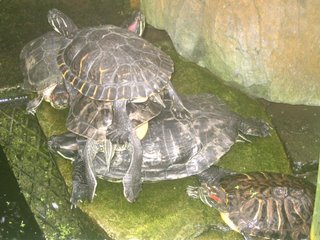 Terrapins basking at les Jardins des Plantes, Caen
Terrapins basking at les Jardins des Plantes, Caen
We strolled the city, visited the imposing Norman castle which, unlike the châteaux on the Loire, was built for defence rather than beauty. We noticed police on the battlements and convoys of them started to appear on the streets. Soon it became apparent there was to be a mass demonstration by young people opposing the French Government's plans for the CPE (a first contract of employment for young people entering the workforce) fearing it will make it easier for employers to exploit them. The French excel at strikes, marches and demonstrations – known as "manifestations" or just "manifs." In the event it seemed to have passed off peacefully with hundreds of banner-waving, chanting students banging their way through the city centre surrounded by police motorcycles. An egg was hurled nearby, landing at Ian's feet, so we decided it might be best to leave the fun behind and make our way home through streets crowded with diverted traffic.
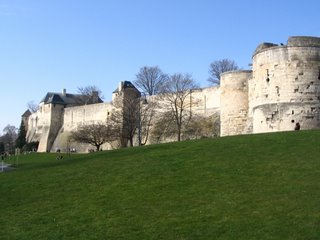 Castle battlements, Caen
Castle battlements, Caen
 Students from the University of Caen demonstrating against the CPE
Students from the University of Caen demonstrating against the CPE
Calling off for a bottle of wine and a dessert for supper we were delighted to discover a huge chocolate and cream gateau intended for 10 people obviously wrongly priced at 1.45€ in the food chiller and we almost got it through the scanner at the exit without anyone realising. Lots of fuss was made by the management but it seems French law is the same as English and if it is wrongly marked, that's the price they have to charge. As Leclerc is a massive supermarket chain we had no compunction about the company's ability to sustain the loss and carried home our prize in triumph.
Together with our hostess, we spent a wonderful evening enjoying pizza and salad, deep red wine and mega-huge quantities of chocolate gateau. It has been such a pleasant end to our visit. Tomorrow we head back to England for a while.
Wednesday 15th March 2006, On board the Mont St Michel crossing between Oustreham and PortsmouthThis morning we left Caen in sunshine around 7.30pm and made our way to the ferry port around Caen's ring road - the péripherique in the morning rush hour. The ferry port is only about 20 kilometres from Caen and we had soon loaded Modestine onto the car deck and made ourselves comfortable in the cafeteria with a full English breakfast! As soon as we smelled the sausages we were lost! After months of continental breakfasts of croissants, baguettes and doughnuts, tucking into eggs, sausages, bacon, tomatoes and baked beans with brown sauce, toast and coffee was unexpected bliss – even after last night's love affair with the chocolate gâteau!
Somehow we have managed to become members of the Brittany Ferries property owners club. This not only gives us a substantial reduction on the price of our fare, it also entitles us to a complimentary cabin on certain crossings. So Ian is lounging back reading one of the first English newspapers we've seen for months while Jill has electricity and a comfortable table and chair to tidy up this final blog before we return to continue our travels in a couple of weeks. We are now off to stroll on the deck. We offer our sincere thanks to everyone for following us so far and hope you will continue to accompany us during the second half of our gap year.
 Dancers in the Eglise Notre Dame de la Gloriette, Caen
Dancers in the Eglise Notre Dame de la Gloriette, Caen Leaving the concert at Eglise Notre Dame de la Gloriette, Caen
Leaving the concert at Eglise Notre Dame de la Gloriette, Caen 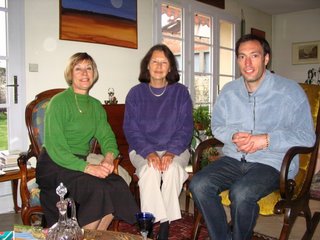 With Claire and Marc in Caen
With Claire and Marc in Caen The market hall and former tithe barn, St. Pierre-sur-Dives
The market hall and former tithe barn, St. Pierre-sur-Dives Craft display inside the market hall, St. Pierre-sur-Deves
Craft display inside the market hall, St. Pierre-sur-Deves Old butchers' stalls, St. Pierre-sur-Dives
Old butchers' stalls, St. Pierre-sur-Dives On the Greenwich meridian, St. Pierre-sur-Dives
On the Greenwich meridian, St. Pierre-sur-Dives The abbey cloisters, St. Pierre-sur-Dives
The abbey cloisters, St. Pierre-sur-Dives Making friends with the natives, St. Pierre-sur-Dives
Making friends with the natives, St. Pierre-sur-Dives Ian checks out the facilities, St. Pierre-sur-Dives
Ian checks out the facilities, St. Pierre-sur-Dives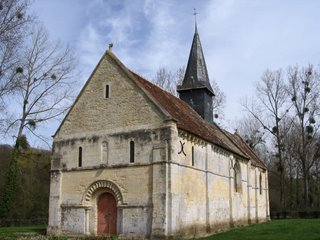 Ste. Marie-aux-Anglais
Ste. Marie-aux-Anglais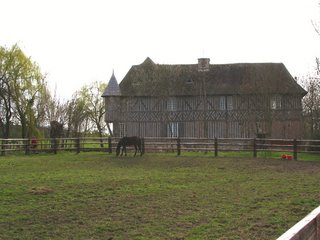 Coupesarte
Coupesarte Geneviève's house with the trellis proudly installed
Geneviève's house with the trellis proudly installed Time to move on
Time to move on Celebrating in the Nepalese restaurant in Didcot
Celebrating in the Nepalese restaurant in Didcot Late Christmas dinner with Neil, Jeev, Kate and Joe
Late Christmas dinner with Neil, Jeev, Kate and Joe Handing our bags for contribution to Banque d'Alimentation, Caen
Handing our bags for contribution to Banque d'Alimentation, Caen Ian enjoys lunch in the garden
Ian enjoys lunch in the garden Geneviève and Jill on the terrace
Geneviève and Jill on the terrace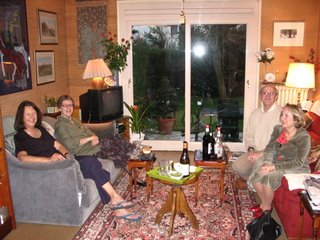 Relaxing with an aperitif
Relaxing with an aperitif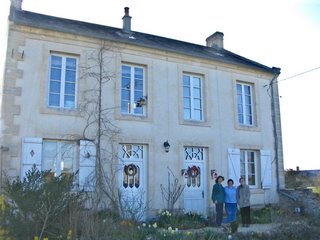 The old school house
The old school house The river Indre in flood
The river Indre in flood Loches and the tower of the Collegiale
Loches and the tower of the Collegiale The 11th century donjon at Loches
The 11th century donjon at Loches Porte des Cordeliers, Loches
Porte des Cordeliers, Loches Gateway through the ramparts, Loches
Gateway through the ramparts, Loches Logis Royal, Loches
Logis Royal, Loches Chancellerie, Loches
Chancellerie, Loches Le Château de Pocé
Le Château de Pocé Ruines of the château at Lavardine
Ruines of the château at Lavardine 12th century fresco depicting the Passion, St. Genest, Lavardine
12th century fresco depicting the Passion, St. Genest, Lavardine Last judgment - condemned souls pushed towards the devil, 12th century, St. Genest, Lavardine
Last judgment - condemned souls pushed towards the devil, 12th century, St. Genest, Lavardine Washing of the disciples' feet,12th century, St. Genest, Lavardine
Washing of the disciples' feet,12th century, St. Genest, Lavardine Christ in majesty in a mandorla surrounded by symbols of the evangelists, 12th century, St. Genest, Lavardine
Christ in majesty in a mandorla surrounded by symbols of the evangelists, 12th century, St. Genest, Lavardine Tree of Jesse, Mary and King David enthroned, 12th century, St. Genest, Lavardine
Tree of Jesse, Mary and King David enthroned, 12th century, St. Genest, Lavardine Capital, late 11th century, St. Genest, Lavardine
Capital, late 11th century, St. Genest, Lavardine Baptism of Christ, late 12th century, St. Genest, Lavardine
Baptism of Christ, late 12th century, St. Genest, Lavardine St Thibault and St Maur, 15th century, St. Genest, Lavardine
St Thibault and St Maur, 15th century, St. Genest, Lavardine Sand yachts on the beach at Ouistreham, Normandie
Sand yachts on the beach at Ouistreham, Normandie Brittany Ferries ship leaving Ouistreham for Portsmouth
Brittany Ferries ship leaving Ouistreham for Portsmouth Seafront houses at Ouistreham, Normandy
Seafront houses at Ouistreham, Normandy All the ladies at the supper party
All the ladies at the supper party Terrapins basking at les Jardins des Plantes, Caen
Terrapins basking at les Jardins des Plantes, Caen Castle battlements, Caen
Castle battlements, Caen Students from the University of Caen demonstrating against the CPE
Students from the University of Caen demonstrating against the CPE Goodbye to the Adelaide
Goodbye to the Adelaide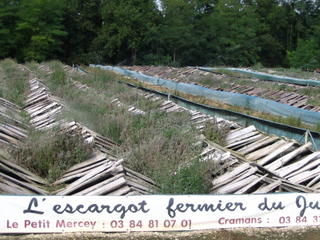 The snail farm on the route between Champagne and Arc et Senans
The snail farm on the route between Champagne and Arc et Senans